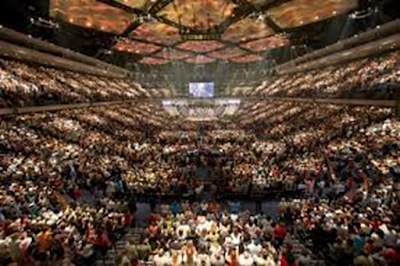I admire
Lakewood.
The Lakewood Yeshiva is the largest yeshiva in the world and plays a major role in the yeshivish community today. I am, however, actually referring to the Lakewood Church in Houston, Texas.
Lakewood Church is led by Joel Osteen, one of the most popular preachers in America today. From very humble beginnings, Lakewood is now housed in what used to be the home of the Houston Rockets, the Compaq Center. Each week, the main service attracts 16,000 worshippers with thousands more attending other Sunday services.
Lakewood is part of the megachurch phenomenon in the US. A megachurch is an American term for a Protestant church having 2,000 or more people in average weekend attendance. There are more than 1,300 in the US with around 50 churches having an average attendance exceeding 10,000. The Yoido Full Gospel Church in Seoul, South Korea attracts more than a quarter of a million people each week. (Talk about soul!)
What can explain the extraordinary appeal of the megachurches? In a word: Mishkan. It has the right name for a successful, mega-congregation: Tabernacle, and it had some 600,000 members.
What is the secret to the Mishkan modeling successful religious engagement and inspiration. The Mishkan combined a sense of obligation, mission, and purpose with finding joy.
Throughout the account of the construction of the Mishkan in Parshat Pekudei, we find the refrain, “ka’asher tziva Hashem et Moshe” – as the Lord commanded Moshe” some 18 times. Why are there so many? A Mishkan requires obedience to the will of the Creator. God makes demands, and we are His people. It is much more than following rules. Rabbi Yoel bin Nun, an Israeli educator, explains that the layer of obligation in constructing the Mishkan creates the framework for connecting to God. While God is accessible to any who reach out, a framework is helpful. Following directions enables the creation of a lasting, sacred means to serve God.
Yet, this is not enough.
When Moshe sees everything is completed, he blesses the Jewish people. Rashi fills us in on the text of Moshe’s blessing:
"Yehi ratchon she-tishre shechinah b’ma’aseh yedeichm - May it be God’s will that the Divine presence reside within the work of your hands." Moshe then adds the verse, “Vi-yhi noam Hashem Elokeinu aleinu…– May the pleasantness of the Lord our God be upon us…” (Tehillim 90)
We can understand Moshe’s hope and prayer that God’s presence rest within the Mishkan, but what about the pleasantness?
The Mishkan must be enjoyable. Strict adherence to the detailed laws and guidelines is critical, but insufficient. Besides obedience, the congregation must incorporate “noam Hashem Elokeinu,” an aura of pleasantness, of joy and of meaning.
At times, the commitment to complying with God’s guidelines, leads us to minimize the importance of a pleasant, joyous atmosphere that should pervade our homes, our shuls and schools, and our daily lives. Moshe knew this. When he saw that the Mishkan was built according to the rules, he blessed the people to ensure that beauty and joy always be present as well.
Through surveys, researchers have identified a number of the characteristics of successful megachurches. They attract new people including many who haven’t attended any church in a long time. Members bring in perspective members and invite family, friends or coworkers to try it out. Participants are attracted to the worship style, the senior pastor and the church’s reputation. There are multiple portals for engagement.
Any of this sound at all familiar?
You may be thinking that it sounds like Chabad. I would, however, contend that this philosophy that should be shaping any Jewish institution that strives to create a meaning, purposeful, joyous platform to educate and inspire Jews. It certainly is my philosophy.
Some feel the synagogue is past its prime and that God has relocated. One such individual wrote, “There’s a reason the kaddish and the prayers for the sick are the best parts of many services – they’re the only parts people care about. Let’s cut the other parts.” I disagree. We must remain loyal to tradition and maintain the foundation of the service. At the same time, we should always be open to ensuring the joy and relevance of the service.
Megachurches are impressive, but we can look back to the Mishkan for a blueprint to create a Mega-Shul. It’s not only about numbers. The Mega-Shul is a sacred community that remains loyal to what God commanded while being infused with energy, passion, God, tradition, values, and care for others.
The Jews were too generous in donating to the Mishkan. The Torah states, “V’hotair – there was too much.” Halevai! Let our biggest problem be that we become too successful.

No comments:
Post a Comment